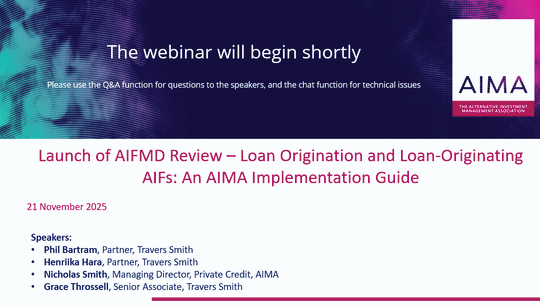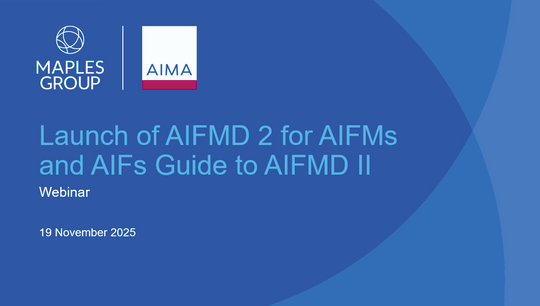The ICAV in Ireland: The story so far
By Ian Dillon, Partner and David Naughton, Associate of William Fry
Published: 13 April 2017
Introduction
The Irish Collective Asset-management Vehicles Act 2015 (the "ICAV Act") came into operation on 11 March 2015, thereby introducing a new type of corporate legal vehicle, the Irish Collective Asset-management Vehicle ("ICAV"), which may be used to establish either a UCITS investment fund or an AIFMD compliant alternative investment fund ("AIF"); typically a qualifying investor alternative investment fund ("QIAIF").
The ICAV adds to a number of existing legal vehicles that may be used to establish investment funds in Ireland, namely; the public limited company ("PLC"), the unit trust, the investment limited partnership and the common contractual fund. ICAVs are first registered as a corporate legal vehicle and then authorised by the Central Bank of Ireland ("CBI") as the chosen investment fund, and the ICAV that was registered was authorised by the CBI on 30 March 2015 as a QIAIF.
On the two year anniversary of its introduction, this article makes some observations on the use of the ICAV so far.
Some observations on the ICAV so far
The creation of the ICAV, and its registration with the CBI, is straightforward and efficient:
- An ICAV is constituted by way of the preparation of its instrument of incorporation ("Instrument"). The Instrument is in large part similar to the constitution of a PLC and does require careful drafting in order to address the nuances of the ICAV Act. Once the Instrument is drafted, we move to the registration process.
- Unlike the PLC, where the Companies Registration Office in Dublin acts as registrar of this legal vehicle under the Companies Act 2014, and the CBI authorises the investment fund as either a UCITS or an AIF, in the case of an ICAV the CBI has assumed the role of registrar of the ICAV, in addition to authorising the ICAV as either a UCITS or an AIF.
- Registration of an ICAV involves completion of a straightforward form and its submission, along with the draft Instrument, to the CBI, which allows two weeks from the date of receipt of a completed application to issue a registration order for a new ICAV. In our experience to date, the CBI generally processes ICAV registration applications more quickly than the allotted 10 business days.
Investors recognise the UCITS or QIAIF brand so familiarity with the ICAV is not a major issue:
From the perspective of brand familiarity, in speaking to investment managers, there is limited concern that the ICAV is currently a relatively new corporate legal vehicle without strong investor familiarity. This lack of concern is due to the familiarity that global investors have with the regulated investment fund structures that may be authorised using an ICAV - the UCITS or the QIAIF.
Conversion to an ICAV or migration into Ireland to become an ICAV is being utilised:
- The ICAV Act permits an existing corporate investment fund authorised in Ireland as a UCITS or QIAIF to convert to an ICAV by way of continuation, using a straightforward registration process. In order to convert a filing is made with the CBI, which subsequently issues a certificate of registration of the corporate investment fund as an ICAV. Importantly, the investment performance track record of the corporate investment fund is not lost as a result of its conversion to an ICAV.
- The ICAV is also available to corporate investment funds from other designated jurisdictions who wish to migrate to Ireland. These investment funds can also register and continue in Ireland as an ICAV without losing their investment performance track record.
- The CBI has confirmed that where a corporate investment fund is migrating to Ireland as an ICAV, the ICAV registration details will need to be submitted 10 business days in advance of the proposed QIAIF or UCITS authorisation day. Provided there are no issues with the registration and authorisation applications, the registration order will issue from the CBI on the authorisation day together with the letter of authorisation of the ICAV as a UCITS or a QIAIF.
Are we witnessing the decline of the use of the PLC as a corporate legal vehicle to establish an authorised investment fund in Ireland?
Between 11 March 2015 and 31 January 2017, the establishment figures for these legal vehicles were: 280 ICAVs as opposed to 40 PLCs (of that number, only 6 PLCs were established in 2016). Whilst it is difficult to be definitive, this trend towards preferring the ICAV may be due to some of the following reasons:
- No risk spreading requirement. ICAVs authorised as QIAIFs have no risk spreading requirement, unlike in the case of PLCs authorised as QIAIFs, making them extremely useful for single asset investment funds, investment funds with very concentrated positions and investment funds which have pro-longed "ramp-up" periods.
- Falls outside of the Companies Act, 2014 in Ireland. ICAVs are outside the scope of the Companies Act, 2014 in Ireland. This
- removes Irish corporate law formalities which were not appropriate for investment funds but mandated for PLCs;
- "future proofs" ICAVs against changes to the Companies Act for the purposes of addressing company law reform;
- New ability to make non-material changes to constitutional rules in an efficient manner. No alteration of the Instrument may be made without investor approval unless the depositary certifies that the changes to the Instrument do not prejudice the interests of investors. This protects investors but also simplifies the process to facilitate standard/non-material changes to the Instrument. This contrasts with the current process for PLCs whereby any change to its constitution requires investor approval.
- New ability to dispense with the requirement to hold an annual general meeting. Unlike a PLC, the directors of an ICAV are permitted to elect to dispense with the holding of an annual general meeting ("AGM") by giving written notice to all of the ICAVs shareholders. There is an investor safeguard in that shareholders holding 10% or more of shares can demand an AGM. This option can be extremely beneficial for investment funds with discretionary investor mandates or where there is a large number of nominee investors who may not return proxy forms or where the investors have indicated a preference to dispense with AGM formalities.
- New ability to prepare separate accounts at sub-fund level. The ICAV Act allows for the preparation of separate sub-fund accounts for an ICAV umbrella investment fund. In contrast, an umbrella investment fund structured as a PLC has to produce one consolidated set of accounts for the entire umbrella structure, which mandates a single year-end date and allows investors in one sub-fund to receive financial details for other sub-funds in the same umbrella.
- New ability to "check-the-box" for U.S. tax purposes. A PLC cannot elect to be treated as a partnership for US tax purposes. If an Irish investment fund wished to attract US investors, until now it would generally be structured in the form of a unit trust. The ICAV has the ability to "check-the-box" to be treated as a "partnership" (if it has more than one investor) or a "disregarded entity" (if it has only one investor) for US tax purposes.
- Ability to revise the ICAV Act. Primary legislation, such as the ICAV Act, may be amended by the parliament of Ireland as the nature of the investment fund industry evolves in the European Union.
A final word
For the investment manager, an ICAV provides a delivery channel to different investor bases, depending on whether the ICAV is authorised as a UCITS or a QIAIF. Irrespective of the investment fund authorisation sought, the benefits of using the ICAV remain, in large part, constant; for example:
- the ability to alter the Instrument without investor approval provided the depositary certifies that the changes to the Instrument do not prejudice the interests of investors;
- the ability to make an election under US 'check-the-box' tax rules, allowing the ICAV to be treated as a partnership or a disregarded entity for US tax purposes; and
- the ability to prepare separate accounts for individual sub-funds of an umbrella ICAV.
It seems that the use of the ICAV will continue to be widespread and its place on the list of potential legal vehicles that may be used by an investment manager for the authorisation of its investment funds domiciled in Ireland is assured.
To contact the authors:
Ian Dillion, Partner, William Fry: [email protected]
David Naughton, Associate, William Fry: [email protected]







